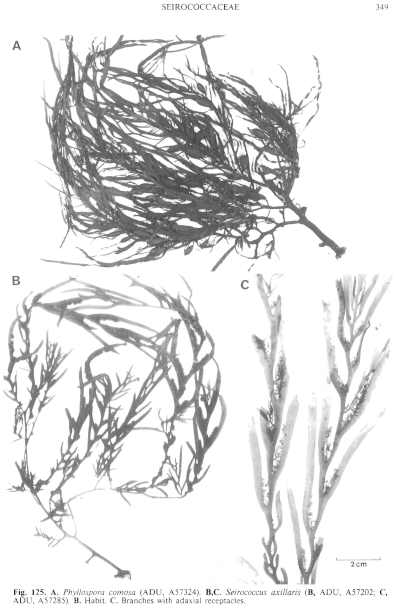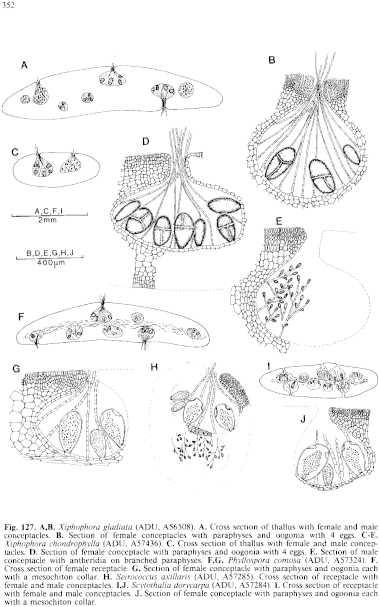|
|
|
|
|
|||||||||||
|
Electronic Flora of South Australia Species Fact Sheet
Phylum Phaeophyta – Order Fucales – Family Seirococcaceae
Selected citations: Harvey 1860: pl. 153. Lucas 1936: 78, fig. 45. Nizamuddin 1962a: 195, figs 3,5; 1968a: 81, figs 1–18, pl. I. Womersley 1967: 252.
Synonym
Fucus comosus Labillardière 1806: 112, pl. 258. Turner 1811: 18, pl. 142.
Thallus (Fig. 125A) dark brown, 0.5–2 (–3) m long, much branched with a short, single, subterete stipe bearing long, flat, primary branches with dense, simple, marginal laterals closely arranged along their length, with scattered vesicles, all essentially in one plane but mostly displaced. Holdfast 1–6 (–12) cm across, with a discoid-conical (sometimes depressed) centre 1–3 cm across, a marginal thickened rim, and radiating, laterally appressed haptera in 1–4 irregular whorls, each 1–4 cm long, 1–4 times branched, 1–3 mm in diameter; epilithic. Branch axes 6–12 mm broad, (0.5–) 1–3 mm thick. Laterals linear to slightly lanceolate, 5–15 (–36) cm long and 3–12 (–20) mm broad, occurring 1–2 mm apart, entire or with occasional slight marginal spines. Vesicles formed at base of occasional laterals, elongate-ovoid to broadly fusiform, usually apiculate or with a short apical leaflet, 2–4 (–5) cm long and (0.5)1–2 cm in diameter, wall 1–3 mm thick. Growth from a short series of four-sided apical cells in an apical depression. Structure with a medulla of elongate cells and hyphae, and a cortex of isodiametric cells, larger inwardly, increasing by a surface meristoderm.
Reproduction: Thalli dioecious. Conceptacles scattered over mature laterals (Fig. 127F), mainly on their basal 2–8 cm; oogonia (Fig. 127G) sessile, ovoid, 130–250 µm long and 80–150 µm in diameter, with an apical mesochiton collar and a single egg, accompanied by simple or basally branched paraphyses 12–16 µm in diameter; antheridia on branched paraphyses, elongate-ovoid, 25–50 µm long and 8–12 µm in diameter.
Type from "Cape van Diemen" (S.E. Tasmania); in Fl.
Selected specimens: Pennington Bay, Kangaroo I., S. Aust., drift (Womersley, 26.i.1956; ADU, A20344). Robe, S. Aust., upper sublittoral pools ( Womersley, 16.xii.1986; ADU, A57324-"Marine Algae of southern Australia" No. 282). Lawrence Rock, Portland, Vic., 8–11 m deep (Larkum, 2.ix.1971; ADU, A39641). Walkerville, Vic., drift (Pope & Bennett, 19.v.1949; ADU, Al2202). Low Head, Tas., 4–12 m deep (Perrin, Aug. 1948; ADU, A9308). Great Taylor Bay, Bruny I., Tas., 2–7 m deep (Shepherd, 7.ii.1970; ADU, A35545). Long Reef, N.S.W., drift (Womersley, 19.iii.1949; ADU, A10187). Lord Howe I. (Maiden, Mar. 1898; NSW, Al292).
Distribution: From Robe, S. Aust., around Victoria and Tasmania to Port Macquarie, N.S.W. Drift specimens known from Encounter Bay and Pennington Bay, Kangaroo I., S. Aust. Lord Howe I.
Taxonomic notes: Phyllospora is common on rough-water coasts in deeper pools and the upper sublittoral, but in Tasmania is common in deep water, more than 18 m deep (Edgar 1984, p. 176).
References:
AGARDH, C.A. (1839). Revision der Algengattung Macrocystis. Nova Acta Acad. Caesar. Leop. Carol. 19, 281–317, Plates 26–28.
EDGAR, G.J. (1984). General features of the ecology and biogeography of Tasmanian subtidal rocky shore communities. Pap. Proc. R. Soc. Tas. 118, 173–186.
HARVEY, W.H. (1860). Phycologia Australica. Vol. 3, Plates 121–180. (Reeve: London.)
LABILLARDIÈRE, J.J. (1806–1807). Novae Hollandiae Plantarum Specimen. Vol. 2. (Plates 231–265 in 1807). (Huzard: Paris.)
LUCAS, A.H.S. (1936). The Seaweeds of South Australia. Part 1. Introduction and the Green and Brown Seaweeds. (Govt Printer: Adelaide.)
NIZAMUDDIN, M. (1962a). Classification and the distribution of the Fucales. Bot. Mar. 4, 191–203.
NIZAMUDDIN, M. (1968a). Morphology and anatomy of Phyllospora, Scytothalia and Seirococcus (Fucales). Bot. Mar. 11, 81–105.
TURNER, D. (1811). Fuci sive Plantarum Fucorum Generi a Botanicis Ascriptarum 'cones Descriptiones et Historia. Vol. 3, pp. 1–148, Plates 135–196. (London.)
WOMERSLEY, H.B.S. (1967). A critical survey of the marine algae of southern Australia. II. Phaeophyta. Aust. J. Bot. 15, 189–270.
The Marine Benthic Flora of Southern Australia Part II complete list of references.
Publication:
Womersley, H.B.S. (14 December, 1987)
The Marine Benthic Flora of Southern Australia
Part II
©Board of the Botanic Gardens and State Herbarium, Government of South Australia
Illustrations in Womersley Part II, 1997: FIGS 125A, 127F,G.

Figure 125 enlarge
Fig. 125. A. Phyllospora comosa (ADU, A57324). B,C. Seirococcus axillaris (B, ADU, A57202; C, ADU, A57285). B. Habit. C. Branches with adaxial receptacles.

Figure 127 enlarge
Fig. 127. A,B. Xiphophora gladiata (ADU, A56508). A. Cross section of thallus with female and male conceptacles. B. Section of female conceptacles with paraphyses and oogonia with 4 eggs. C–E. Xiphophora chondrophylla (ADU, A57436). C. Cross section of thallus with female and male conceptacles. D. Section of female conceptacle with paraphyses and oogonia with 4 eggs. E. Section of male conceptacle with antheridia on branched paraphyses. F,G. Phyllospora comosa (ADU, A57324). F. Cross section of female receptacle. G. Section of female conceptacle with paraphyses and oogonia each with a mesochiton collar. H. Seirococcus axillaris (ADU, A57285). Cross section of receptacle with female and male conceptacles. I,J. Scytothalia dorycarpa (ADU, A57284). I. Cross section of receptacle with female and male conceptacles. J. Section of female conceptacle with paraphyses and ogoonia each with a mesochiton collar.

|
Email Contact: State Herbarium of South Australia |

|